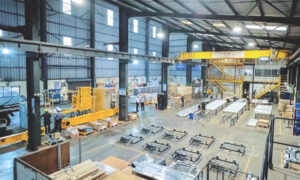This article addresses the challenges and opportunities for cold chain and logistics industry as well as explains how the market will evolve and embrace digital post COVID-19.
Subhajit Roy, Executive Editor
The cold chain and logistics involves the transportation of temperature-sensitive products along a supply chain through thermal and refrigerated packaging in an order to preserve the quality of goods during the transport processes. Thus, cold chain and logistics industry remains an integral part of any industry. In India, keeping pace with rapid socio-economic development, the cold chain logistics market is witnessing significant growth. Studies suggest that, the Indian cold chain market that was valued at Rs 1,28,800 crore in 2019, is expected to exhibit strong growth during 2020-2025.
So far, penetration of cold chain operations remains low in India. According to Srinivas Reddy, Senior General Manager – Commercial Refrigeration, Blue Star Limited, “Cold chain adoption in India is in the range of 3 to 4 percent, currently.”
Though adoption levels vary, it cuts across several user segments, namely, fruits and vegetables, processed foods, dairy and ice cream, pharma and healthcare, and hospitality. A typical cold value chain envisages end-to-end infrastructure right from manufacturing or harvesting till consumption, what we usually call ‘farm-to-fork’ and is operational round the year to ensure perishability of stored commodities. In terms of equipment, it encompasses refrigeration at farm level, grading, sorting, packaging, transport refrigeration, cold storages at distribution hubs and spokes, and last mile storages such as deep freezers, coolers, multi-deck display coolers at merchandising points, and even to domestic refrigerators. Its complexity and depth varies from user segment to segment, like typical cold chain in pharma would be different from hospitality.
“A well-designed cold supply chain is created to balance demand and supply with a provision for buffer to meet consumption spikes, apart from the main objective of reducing wastages along the value chain. An intrinsic goal is also to provide quality produce to consumers by linking production and demand centres seamlessly,” Reddy said.
In a pre-pandemic world, the gap in the Indian cold chain and logistics infrastructure led to nearly 40 percent of India’s total produce, significantly impacting the nutrition gap in the country. According to the recently published India Cooling Action Plan, while India has a large inventory of cold storages or refrigerated warehouses, the remaining elements of cold chain infrastructure such as pack houses, reefer transport, and ripening chambers—are largely missing.
Lockdown Impact
The outbreak of the COVID-19 pandemic has exposed the gaps in the Indian cold chain and logistics infrastructure, exacerbating the challenges faced by the sector. According to Anuraga Chandra, Head, Cooling Sales, Danfoss India, “The breakdown in the supply chain logistics caused by the nation-wide lockdown has lowered transport capacity and restricted movement, depleting the workforce. The displacement of intermediaries, middlemen, traders and wholesalers has caused hindrances to the seamless movement of agricultural and dairy produce from the farm to the marketplace, far reducing the value-capture of the produce. This has also impacted the livelihoods of many throughout the agro-supply-chain.”
Cold chain infrastructure is the link between the farm and the fork – ensuring stable temperatures end-to-end and with the potential to save lives and livelihoods. It bears mention, here, that there has been a notable shift in attitude towards the cold chain industry as an essential service. “Despite the setbacks caused by the outbreak of the pandemic, the cold chain industry has the potential to be one of the growth drivers in India’s economic recovery,” observed Chandra.
Explaining the impact of COVID-19 over India’s cold chain and logistics market, Reddy said, “COVID-19, with all ingredients of a ‘black swan’ event, has completely derailed normal life, bringing everything to a grinding halt with lockdowns and subsequent progressive unlock phases. Though public life has been under lockdown mode, there is no trend of food consumption coming down. But, the consumption model has changed significantly with a clear preference for door delivery, contactless delivery and home cooking. We still needed vegetables, fruits, processed foods and pharma supplies. Of course, for a short time, the technical force manning the cold chain infrastructure which has been forced to stay indoors has put a temporary strain on the entire value chain.”
If not anything, the pandemic indeed highlighted the importance of a robust cold chain infrastructure across the country with restated goal of managing demand-supply gaps. The pandemic has, however, impacted the hospitality segment badly with hotels, restaurants, and fast food outlets facing serious demand contraction due to prevailing restrictions. In other words, food consumption out-of-home is yet to pick up due to pandemic-related safety guidelines. This is likely to continue for some more time. However, in Reddy’s opinion, cold chain related to pharma and healthcare has picked up significantly, especially that of medical refrigeration, during this period. He anticipates that the demand for cold chain and logistics is bound to go up due to developments around vaccine and its distribution.
Technology Shift
The advent of Industrial 4.0 has paved the way for industries to leverage the fast evolving and cutting-edge technologies like IoT, Cloud solutions, AI, automation, etc., to enhance speed and energy efficiency of solutions offered. “Technologies like variable speed drives, applied in the cold chain segment have enhanced the energy efficiency of solutions, while automatically maintaining stable temperatures within cold storage units and refrigerated transport units, regardless of the external temperature conditions,” opines Chandra.
He adds, “Another important development in the segment is the shift from the use of traditional refrigerants to the use of low global warming potential (GWP), low ozone depletion potential (ODP) and natural refrigerants such as Ammonia and Carbon Dioxide based refrigerants.”
Additionally, newer all-electric transport refrigeration equipment is gradually replacing traditional, less sustainable alternatives. These trends have the potential to affect significant reductions in the overall carbon footprint of the industry.
However, Reddy observed: “We don’t anticipate any major technology shifts on account of COVID as the fundamentals of technology deployed in refrigeration and cold chain would remain unchanged. There are no commercially feasible alternates to standard refrigeration cycle consisting of compressor, condenser, evaporator and other components. That said, user interface is likely to undergo a change towards preference for contactless, remote diagnosis and monitoring of refrigeration systems.”
At a broader level, operating models might undergo a shift in a few user segments. For example, a good pick up in food delivery is expected as consumers do not prefer to go out to a restaurant in the current situation. This new trend may give rise to more Cloud and dark kitchens in metros. Dine-in formats may add delivery and take-away options. Similarly, people prefer to have fruits and vegetables delivered at home. Such new market trends may necessitate well-managed back-end infrastructure.
Another similar example is that consumers may like to have ice cream delivered at home rather than walking into outlets. This would force ice cream companies to tweak their distribution strategies, suggests Reddy. “Presuming ice cream companies adopt door delivery model, it may call for mobility systems fitted with refrigeration of some kind.”
He adds, “Home cooking may become a preferred option but due to paucity of time, consumers may shift their preference to ready-to-cook packaged products. Even at residences, available storage capacities may not be adequate considering short-haul, sudden lockdowns and frequent supply chain disruptions.”
Digital Transformation Post COVID
India has a long way to reach refrigeration penetration levels witnessed in developed countries. Changing consumption habits, demand-supply gaps, and young demographics are likely to drive higher adoption in the near future. The country had witnessed a great evolution in milk supply chain driven by end-to-end cold chain adoption. Similar growth in F&V and processed foods segments can be expected. The market is bound to grow well in view of the pressing need to cut food wastages across value chain, claims Reddy. He adds, “There is a greater need to create back-end infrastructure with necessary market linkages.”
India is a consumption-led economy and growth in agriculture and horticulture is quintessential for the GDP growth of the country, apart from enormous employment generation potential the sector has.
“Given our production scale in agriculture and horticulture, India has immense potential to become a food factory to the world, provided a robust end to end cold chain infrastructure is in place. The Govt has launched many policy interventions and incentives in the form of subsidies to promote cold chain in the country. There is scope to double the cold chain infrastructure from the current level,” believes Reddy.
He said, “Digital technology finds its way into contactless and remote monitoring of refrigeration systems, including system diagnosis and predictive maintenance.” Can a user see temperature movements in cold room or deep freezer on his/her mobile? Can a refrigeration technician diagnose a problem remotely and control its operation? The answer is yes. Predictive maintenance through refrigeration system performance analytics is slowly gaining traction. However, Reddy said, “We need cost-competitive and quick-to-adopt digital technologies. Digital tools are being extensively deployed now to remotely train and skill engineers, technicians, trade partners, and create awareness amongst customers. Data analytics is an opportunity area in refrigeration to improve process efficiency and productivity in overall eco-system. In the end, the customer should see the benefit.”
The availability of cold chain infrastructure in India is currently fragmented, and the uptake for a more connected cold chain network across India is still in the nascent stages. While the start-up costs for setting up more robust cold storage and transportation facilities are perceived to be high, the long-term return on investment suggests both increased productivity and profitability. According to Chandra, “Greater investments in cold chain and logistics in the country can provide higher value capture on the farmers’ produce by vastly reducing the levels of food loss, thus proving to be profitable in the long run. This will enable a more seamless farm-to-fork delivery of fresh and high nutrition food, going a long way not only in bridging the nutrition-gap in the country but also meeting the changes in food consumption patterns in a post-COVID world.”
Another apparent challenge in this industry is the significant skill gap among the workforce in the HVAC industry. This can be ably addressed with investments in increased training programs and a close collaboration between key industry players, the government and academia, recommends Chandra.
As we enter a ‘now normal’, the key focus of businesses is to realign strategies and processes to accommodate the changing customer behaviour and to enable a low-touch low-carbon economy as the way-forward for growth. In Chandra’s opinion, the sole priorities of businesses going forward will be that of achieving sustainable growth. A critical component of this strategy will be a complete digital transformation of the industry. Smart technologies, AI and IoT enabled solutions, data driven technologies, etc, can enhance automation and reduce the need for human intervention to a great extent.
Chandra concludes by saying, “With the increasing shift towards digitalisation, we envision a ‘digital’ cold chain and logistics sector marked by end to end connectivity throughout the supply chain. Heightened connectivity can automate and pre-empt delivery and procurement timings, maintenance activities among others, affecting savings on time and costs.”
Despite the setbacks caused by the outbreak of the pandemic, the cold chain industry has the potential to be one of the growth drivers in India’s economic recovery.
Anuraga Chandra, Head, Cooling Sales, Danfoss India
The demand for cold chain and logistics is bound to go up due to developments around vaccine and its distribution.
Srinivas Reddy, Senior General Manager – Commercial Refrigeration, Blue Star Limited.
Cookie Consent
We use cookies to personalize your experience. By continuing to visit this website you agree to our Terms & Conditions, Privacy Policy and Cookie Policy.














